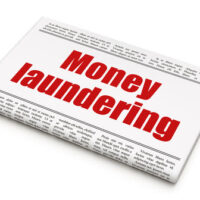Breaking Down the Three Stages of Money Laundering

By design, money laundering involves camouflaging profits obtained from illicit activities or exploitation into presumably “authentic” resources. Through a series of “cloaking”, or layering, individuals are able to take dirty money and turn it into legitimate earnings without drawing attention to law enforcement.
Common methods of unloading surplus cash obtained illegally involves ‘rinsing’ money through legitimate enterprises, like diners or bail bonds companies. Daily receipts will show legitimate transactions inflated to account for excess funds deposited into the business’ bank account.
Money laundering is often a three-step process, which is underscored below.
Step #1: Placement
Ill-gotten gains must enter the cycle somehow. The first step, known as placement, introduces money into the financial system. This may happen by selling narcotics, killing people for profit, sex trafficking, or illegal gambling. “Dirty money” has no legitimate means of being obtained.
Once money is placed into the system, it must go somewhere.
Step #2: Layering
To eventually receive legitimate money, one must clandestinely veil the source of illegitimate funds. In doing so, the art of layering is born. It’s not just the most important step in the money laundering process, but also the hardest. With today’s technological advances and lack of transnational cooperation, layering is becoming much easier than ever.
As discussed during introduction, legitimate businesses are formed as normal. Transactions are recorded, and deposits are sent to company bank accounts. The difference here is the somewhat larger deposits being recorded nightly exceed what products or services were actually sold. But since police rarely audit nightly deposits, nothing is suspected.
Restaurants, nightclubs, auto repair shops and any other business where the cost of goods can be adjusted nightly are prime targets for money launderers. Once enough distance has been placed between dirty money and “good” business assets, it’s time to get some clean funds.
Step #3: Integration
After essentially rinsing the dirty money through regular course of business in legitimate operations, withdrawing money from one’s business bank account creates a paper trail. That trail shows good money was withdrawn from a legitimate business account, which then allows that money to be “integrated” into the local economy.
Unless law enforcement can cut off money heading into the legitimate business (the “front”), money laundering is rather difficult to charge.
Know Your Rights
If you’ve been accused of money laundering, it’s important that you learn not only what rights you’re afforded, but what laws regarding illegal search and seizure exist. Detectives may want to freeze assets or wipe out bank accounts, but aren’t permitted to do so without substantial evidence the business bank account rinsed money.
Also, know that laundering money can turn into RICO charges if you’re found guilty of funding a criminal organization. Therefore, it’s important to remain silent and contact an attorney knowledgeable in the three stages of money laundering, and the defenses to use in each stage.
State and federal charges of money laundering are serious. It’s imperative persons accused of this crime contact Perlet & Shiner, P.A. in Palm Beach as early on in the investigation as humanly possible to assure your rights are preserved.
Resource:
ft.com/content/0397fc40-b281-11e8-87e0-d84e0d934341
